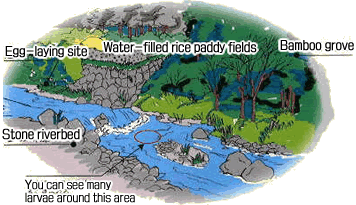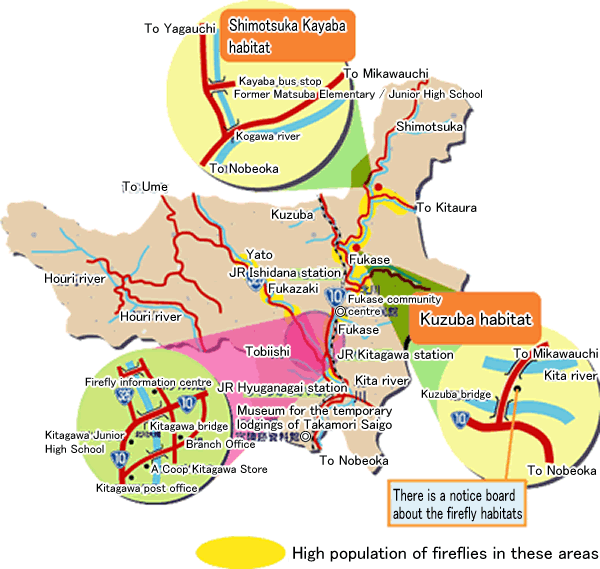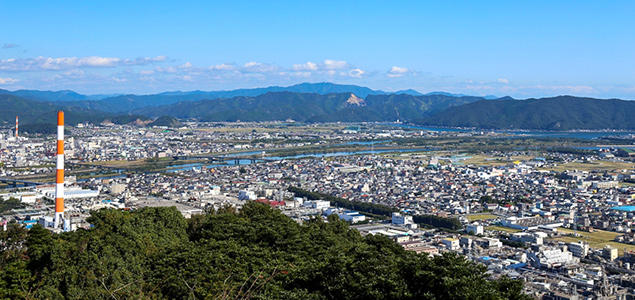本文
The Fireflies of Kitagawa
The Habitat of Fireflies
Through Kitagawa flows the wide Kitagawa River and its tributaries. Beginning deep in the mountains as a modest stream, it twists and turns, rushing over rocks here, or forming tranquil pools there, and eventually flowing together as a beautiful river. Shizumi Bridge, which was built over the Kitagawa River had no decorations or even a handrail in the past. Now this bridge as well as many other old suspension bridges and stone bridges have been transformed into large modern bridges one after another. While the living environment has changed along with the natural environment, the clear streams of the Kitagawa River remain unaltered, gathering all the tributaries and flowing through Nobeoka and out to the Hyuga-nada Sea.

Types of Fireflies Inhabiting Kitagawa
Kitagawa is the perfect habitat for Genji fireflies because of its clear running waters and the presence of Semisulcospira libertine (a type of snail which is the food of choice for the Genji firefly larvae). If you pop on a pair of goggles and dive underwater, you will be surprised to find a lot of Semisulcospira libertine. It has been confirmed that regions where there is a large distribution of Semisulcospira libertine often have a higher incidence of Genji fireflies. Therefore, we can assume that any efforts to protect Genji fireflies from extinction must begin in protecting and improving the river's ecosystem. If the aquatic environment is preserved and improved, we can hope to see an increase in the Semisulcospira libertine population and a resulting increase in the number of Genji fireflies.
In Kitagawa, currently four types of fireflies have been confirmed and can be seen in places such as Shimo-aka. The first is the Genji firefly that can be seen all over the entire area. The second is the Heike firefly that can be seen in the vicinity of drains near rice paddies. The third is the Hime (Princess) firefly which glows during both its larval and adult stages. Finally, the fourth type is the Oba (Old Lady) firefly which does not glow as an adult. There may be many more species of firefly living in the area that have yet to be discovered!
Amongst these four species, Genji fireflies emit the biggest and brightest light, slowly flickering on and off at roughly two-second intervals. Females are bigger than males, but fewer in number. Genji firelies feed on Semisulcospira libertine as larvae but after it reaching adulthood, they consume on only a small amount of water for the remainder of their lives (approximately 1-2 weeks).

Luminous part

Male

Female
Life as a Genji Firefly

Though there is a slight difference year-to-year depending on the temperatures, the Genji fireflies in the the Kitagawa River basin usually appear all at once from around late May to mid-June. The fireflies seen flying around are the males, while the females stay in the shrubs and foliage. Adult activity peaks at three times during the day: 7:30-9p.m., around midnight, and then around 2a.m. At these times, both males and females try as hard as they can to find a mate through emitting light. After mating, the male dies and the female lays her eggs. Places to lay eggs are generally limited each year and the places are rather centralized.
Egg-laying continues from 8pm in the evening until 3am the next morning. Each female firefly lays around 800-1200 tiny yellow eggs and then dies. The eggs have an incubation period of approximately 30 days, after which the larvae hatch to start their life underwater, living under rocks in the riverbed. The larvae begin to move when night falls, since they are nocturnal. They eat any Semisulcospira libertine that they come across. The larvae shed their skin about six times during their growth period. Interestingly, they light up during both the egg phase and the larval phase.
Genji firefly larvae stay underwater until around March of the following year. In April, they leave the water and dig deep into the soil of the riverbank where they proceed to build a chrysalis. They emerge from their cocoons as mature adults following a period of metamorphosis lasting approximately 30 days. This cycle repeats year after year.
Firefly Habitat Map

When you go firefly-watching, please keep the following points in mind.
- Fireflies are organisms that live in the natural environment. Please do not attempt to catch them or take them home.
- Please take care when walking or driving around at night.
- Please park in designated parking areas only.
- Please take all trash home with you.





